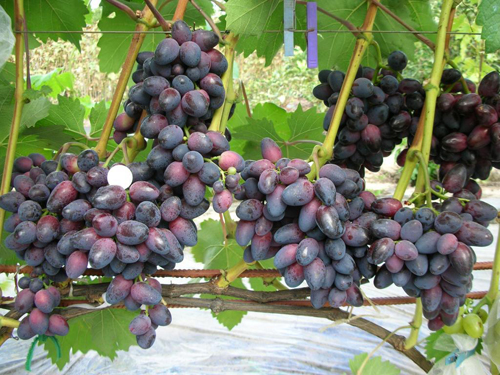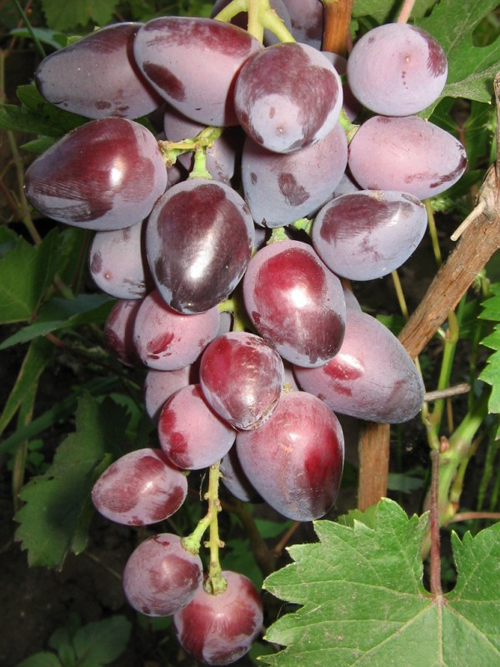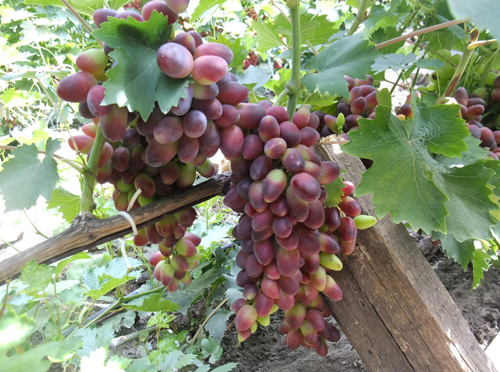Grape variety Beauty
The hybrid form of table grapes Krasotka is one of the first works of amateur breeder Yevgeny Pavlovsky, who has been creating new varieties of solar berries on his site in the Rostov region for more than twenty years.
For the former miner, the path to a new business of life began in the distant 1983, when he took up amateur viticulture, at that time without any thoughts of breeding new varieties and hybrids. He took his first steps in this field under the mentorship of Demyan Yemelyanovich Filimonov and Alexander Ivanovich Pershikov. They helped a novice vine grower to master the specifics of crop cultivation, to achieve a decent yield, to learn how to graft and grow seedlings. Evgeny Georgievich started breeding on the advice of Ivan Kostrikin, an outstanding scientist from the Novocherkassk Research Institute of Viticulture and Winemaking. At first, he only crossed various varieties and hybrids of grapes, and transferred the obtained seeds to the Institute, where seedlings were already grown from them and the most promising ones were selected. But already since 1997, Pavlovsky has closed the cycle of breeding work, starting to independently sow hybrid seeds and test the resulting seedlings. The business immediately went well, and one of the first varieties identified was Pretty Woman, which the author considers one of his best forms for the taste of berries.

Our heroine was born from the pollination of a complex interspecific hybrid Victoria, selection of the above-named Institute, with a mixture of pollen of the European-Amur forms of grapes. Thus, in her DNA, you can find an intricate cocktail of genes of European, Amur and American species, which determined the pretty good qualities of Beauty. In addition to its amazing taste, its assets include early ripeness, attractive appearance of berries, good storage and transportability. Among the shortcomings, winegrowers note a tendency to shedding flowers, periodic peas of grapes and their cracking in the event of a sharp drop in soil moisture during the ripening period. Fortunately, all these negative traits are not critical, and with proper care, the variety pleases its owners with decent yields of good quality. It is not for nothing that he is still loved and appreciated by numerous fans, even despite the appearance in recent years of a huge number of various new products, each of which is presented as another masterpiece.
Agrobiological characteristics
Grape bushes of medium to above medium vigor. The crown of a young shoot is open, reddish-green, with a noticeable bronze tint of young leaves, without pubescence. The formed leaf is large, five-lobed, stretched in width, has a strong dissection between the lobes. The leaf surface is smooth, dark green; the back side is without pubescence. The upper side notches are deep, open, lyre-shaped with a pointed bottom, or closed with a narrow elliptical lumen. The lower notches are much shallower, barely outlined or V-shaped. The petiole notch is open, wide, vaulted with a flat or pointed bottom. The petiole is long, green with red longitudinal stripes. The denticles along the edge of the leaf are large, triangular and saw-shaped, heterogeneous in size, with somewhat convex edges and rounded apices. The Flowers of the Beauty are bisexual, however, despite this, the variety is prone to peas in unfavorable seasons for flowering. Ripening of annual shoots is good - 80-90%.
Bunches of grapes are of medium size, elongated-conical in shape, while they can be with one or more wings, of moderate density or loose. The average mass of ripe brushes is 350-500 grams, but some, especially with a low load of the bush with a crop, can reach a kilogram weight. The stem of the comb is long, strong, light green in color.The berries are quite large - about 30 mm long and 19 mm in diameter, elongated with a pointed tip, weighing about 6-8 grams. The color is dark pink, often with a transition to a darker purple tip. The uniformity of grapes in a bunch is unstable, and varies from season to season. The pulp of the variety is juicy and fleshy, with a very pleasant, refined and memorable taste. Uncolored juice, contains 15-16% sugars, with an acidity of 5-6 grams / liter. The skin is very thin and fragile, it is not felt at all when eating, the outside is covered with a thick pruin bloom of light color. The seeds are present in the berry, but due to their small size and quantity, they do not have a negative effect on gastronomic properties. The tasting characteristics of fresh berries are very high. It is for the outstanding taste that many admirers forgive the Beauty for those problems that she often has during flowering.

The harvest of this variety is used for fresh consumption, although its use in home canning cannot be ruled out. It is quite possible to make delicious jams and compotes from it. Grapes are rightfully considered very "marketable", buyers willingly take it, and after having tasted it, they return for it again and again. If it is possible to grow a crop without damage by pests or as a result of cracking, then, in addition to its wonderful taste, it is also characterized by excellent suitability for storage, as well as for transportation over long distances, without reducing the presentation of the bunches. Storage should be carried out in special rooms or refrigerated chambers at a temperature of + 2 ... + 4 ° C. In this case, the grapes should be hung on a wire, or neatly laid in one layer on a bed of straw or sawdust.
The beauty has an early ripening period. The growing season from the moment the buds open in the spring until the harvest is ready for harvest is 110-120 days. At the latitude of Rostov-on-Don, ripening occurs in the second decade of August. The demand for heat during this time is characterized by a rather modest sum of active temperatures - 2250-2350 ° C. Thus, it, like the parent variety Victoria, can be grown without any problems throughout Ukraine, in the south of Belarus and central Russia. Naturally, provided that the vines are sheltered for the winter in frost-prone regions. Resistance to low winter temperatures, despite the presence of Amur grape genes in the DNA, is rather average. According to the originator, the vine can withstand frosts down to -23 ° С, however, there is still no confirmation or refutation of this hypothetical figure. Many growers, reinsuring themselves, shelter the bushes for the winter, even in the south.
The productivity of the variety is very variable over the years and, most likely, from region to region. This is due to the predisposition to shedding buds before flowering. On this occasion, there is a lot of conflicting evidence: some happy owners of Beauty claim that they practically do not encounter this problem, regularly receiving a lot of bunches from it, others, on the contrary, are filled with disappointment due to an almost annual loss of harvest at the flowering stage. For this reason, it is quite appropriate to assume that it is the climatic and soil conditions of a particular place of growth that can provoke massive shedding of flowers, however, the hybrid has not yet been sufficiently studied to draw any definite conclusions on this matter. Where it is still possible to grow the crop, growers get 10-15, or even more, a kilogram of delicious bunches from a bush. Those who are unlucky in this regard have to be content with the results much more modestly, but even here the amazing taste of grapes often does not allow the owner to take up the ax to say goodbye once and for all to such a capricious inhabitant of his site.

After ripening, the harvest of this variety is not recommended to be left hanging on the bush, since the berries crack easily when the soil moisture changes in case of rain. In addition, sweet grapes are the coveted object of attention of such malicious pests as wasps, and Beauty's thin skin does not protect her from these attacks.Therefore, it is better to take care of protection even at the ripening stage, and for a guaranteed result, the best option would be to place the bunches in individual bags, where they will become inaccessible to insects.
Agrotechnical features
Planting Pretty Woman in phylloxera distribution zones should be carried out with seedlings grafted onto phylloxera-resistant rootstocks, since there is no information on resistance to this pest. It grows well with the most popular rootstocks such as Riparia x Rupestris 101-14 and Berlandieri x Riparia Kober 5BB, as well as many already planted grape varieties. In a self-rooted culture, the hybrid should be planted only in areas that are guaranteed to be free of root aphids.
Young plants grow quite actively and begin to bear fruit early. Already from the second year, it is necessary to decide on the formation of the bush, which, in turn, will depend on the plans for sheltering the vines for the winter. In the northern regions, the need to protect Beauty from frost is not even discussed. There, the variety is formed according to the principle of an oblique (inclined) cordon or multi-arm fan, with the removal of the sleeves from the trellis in the fall and covering them with earth, or insulation with organic materials, followed by insulation with a waterproof material to prevent the eyes from fading out on the vine. In the south, in traditional wine-growing regions, you can try to apply a semi-covering formation, in which most of the grape bush is located on an uncovered trunk, and only an additional lightweight layer is protected from frost. In case of severe damage to the main part by cold, the remaining reserve will allow you to quickly restore the bush. Thanks to such a scheme, it will be possible, without the risk of complete freezing of the plant, for certain to determine the frost resistance of the hybrid in your climate, as well as to seriously reduce labor costs due to the significantly smaller volume of the covered vine.
Already formed fruiting plants are loaded very moderately. In the case of Pretty Woman, this is the very case when the option is justified - the less, the better. The maximum load is recommended at 30-40 eyes per bush with an average pruning length of 5-8 buds per fruit arrow. Naturally, you will also need a fragment of weak and sterile shoots of grapes, but the thinning of the brushes should be postponed until the beginning of the growth of berries on them. This is due to the main problem of the variety - shedding of flowers, which can be inadvertently increased by conducting green operations in the vineyard during this period.
Unambiguous recommendations against shedding with a guaranteed result cannot be given for Beauty, since the early pinching of shoots, traditionally used for this purpose, can in this case give a negative effect in the form of a rapid formation of stepchildren with no less growth force than the main shoot. Therefore, if you are unlucky enough to face such a problem with a given variety of grapes, it makes sense only to try using various chemicals that are recommended to prevent shedding.
Also, winegrowers are often not enthusiastic about Beauty due to the tendency to cracking berries during the ripening process, due to which the presentation of the bunches of this variety is significantly deteriorated. At the same time, if they are not quickly realized, then the harvest may completely disappear due to the rapid development of rot on damaged grapes. In order to prevent this, you need to carefully monitor the maintenance of the optimal water balance in the soil, prevent its excessive drying out or waterlogging, and even more so a sharp change in these states. A good result is shown by mulching the soil under vines, and, of course, regular watering during dry growing seasons.
With regard to the fight against grape diseases, it is worth demonstrating flexibility and the ability to respond quickly to their occurrence. Of the obligatory chemical treatments, only the main ones are recommended - before and after flowering with tank mixtures or complex preparations against mildew and oidium. In the remaining periods of the growth of the bush, you need to carefully monitor the presence of signs of the multiplication of pathogens, identify them and apply the necessary plant protection products. Do not forget that with the beginning of the softening and staining of the fruits, most fungicides can no longer be used, so as not to damage your own health.
Summing up, Krasotka should be recognized as not the most stable and studied variety from an economic point of view. However, the existing positive qualities and love of admirers do not allow her to be written off. Moreover, we can recommend it to those gourmets who, for the sake of high taste, are ready to take a certain risk. After all, it is quite possible that it is in their conditions that our heroine will show herself in all her glory, just as she does it with many other winegrowers, who characterize her only from the positive side.








